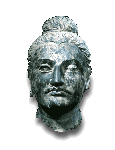
|
ARH 382 |

|
ARH 382 |
 |
>> | Reading Questions | >> | The Maha-Parinibbana |
This Sutta (Sutra) is admittedly difficult to read and you will be tempted to go over much of it very quickly. Note, however, the way in which repetition occurs-for what purpose?-and the manner in which space is conceptually and verbally constructed. The following questions may help you as you read this material:
- At the beginning of Chapter !, we are presented with four 'actors': the King of Magadha, Agatasattu: his prime minister and emissary, the Brahman Vassakara; the 'Blessed One,' Buddha; and Ananda. They represent several different 'poles' or social dynamics within the world of early Buddhism. How would you describe each and their relationship to each other and to the larger world? Note here and throughout the emphasis laid on discussion.
- It is clear that Buddha has great respect for the social fabric of the Vaggians. How would you characterize that fabric? What is the relationship between the Buddha's teachings and this social contract of the Vaggians? (5)
- If you had to draw out the spatial relationship between the King Agatasattu and Buddha, what would it be? That is, what is the space that separates them? (3)
- In Chapter 1, Buddha spells out the rules of a Buddhist community; these rules will govern the organization of Buddhist communities across Central Asia. What are they? What kind of a community do they describe?
- What is the economic nature of the Buddhist order as described by the Buddha (11)? How, do you gather, do the members of the order live? What are the sources of their livelihood?
- Consider the central message of the Buddha's teaching, as expressed in Chapter I, section 12. What are the implications of that teaching for the way a person would pursue life 'in the world' or in the order?
- Much of the first part of this sutta involves the Buddha going about the country and staying with various kings or groups, or speaking with his disciple, Ananda. What is the purpose of this activity? What is happening?
- In Chapter II, sections 5 - 10, the Buddha essentially explains the principle of karma.. How does it work? Or rather, how does one escape karma?
- What lesson can be gathered from the Buddha's encounter with Ambapali, the 'mango girl'? (Chap. II, 16-25)
- As he prepares to die at age 80, the Buddha , Tathagata, offers advice to Ananda that would be central to the Theravada understanding of salvation (II, 33). What does he mean when he says that a disciple should be a 'lamp unto himself'?
- In Chapter III we find, again, the confrontation of Mara and the Buddha, following Ananda's plea to the Buddha to remain in this world and Ananda's continuing plea. There is a critical tension that emerges here, between the Buddha's and Mara's understanding of the Buddha's mortality and Ananda's desire to deny that mortality. Understand how that is expressed. What is the sense of the Buddha's words in III/7?
- Notice that throughout this sutta space is expressed in terms of discrete places and not in terms of the extension between those spaces. See, for example, the long section where the Buddha speaks to Ananda about places that have been unusually 'pleasant' (III, 54 ff). How would you represent such a spatial 'world' if you were an artist?
- In Chapter V we are told how the Buddha prepared himself for death and we are given a description of the setting (4 - 5). How would you render that visually?
- In V, 16-22, we see the importance placed on the experience of pilgrimage . Is this expressed in terms of journey or discreet places?
- In V, 25-26, we see the origins of the Buddhist stupa (dagaba). How does it relate, in this text, to the treatment of the body?
- In Ch. V, notice who comes to pay final respects to the dying Tathaghata: the Mallas of Kusinara (arranged in family groups) and the mendicant 'nonbeliever' Subhadda,.
- What was the response of the brethren to the Buddha;s death? (VI/19). What is the difference in response between the brethren and the Arahats? (see V/62, p. 107, note 1)
- In Ch. VI/36-39, we see a scene involving Maha Kassapa and a 'naked ascetic,' Who is going where and what happens? This scene will become grafted onto scenes of the death of the Buddha.
- What is the further action of Maha Kassapa? Is he one of the brethren or an Arahat?
- VI/48 ff. : what was the reason for the division of the relics of the Buddha? And what do the people want to do with the relics? Note how this relates to the development of the Buddhist stupa.
|